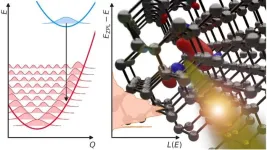(Press-News.org) New evidence has emerged about the long-term effects of the COVID-19 pandemic in Los Angeles County, as shown by a recent study in the journal PLOS ONE. Scientists at USC and the Los Angeles County Department of Public Health (DPH) found that existing disparities in mental health between white and non-white residents worsened.
The study used two surveys conducted in 2018 and in spring 2021 to measure the risk for major depression among adults, alongside data about death rates. The researchers considered monthly averages between March 2020 (when the earliest shelter-in-place orders were issued) and mid-April 2021 (following the height of the pandemic). The county was divided into three zones based on this data:
a high COVID-19 mortality area spanning metropolitan L.A., South L.A. County and East L.A. County;
a low COVID-19 mortality area comprising West L.A. County and the South Bay;
and a middle COVID-19 mortality area encompassing the San Gabriel, San Fernando and Antelope Valleys.
Perhaps predictably, residents in areas with high COVID-19 mortality were more likely to face risk for depression compared to those in areas with middle and low COVID-19 mortality. But when the researchers grouped survey respondents by race, they found a stark division. They observed an overall trend of increasing depression risk in harder-hit areas among non-white L.A. County residents, including those from Asian, Black, Hispanic, and Indigenous racial and ethnic groups, but not for white residents.
In 2021, non-white respondents in the area most impacted by COVID-19 deaths were more likely to be at risk for depression than their peers in the low COVID-19 mortality zone.
Even back in 2018, the risk of depression was more prevalent among non-white residents of metro L.A., South L.A. and East L.A. than among non-white residents of West L.A. and the South Bay. By 2021, that gap grew. The effects documented by the researchers persisted even after adjusting for other factors.
“The pandemic hit non-whites much harder than whites, and we speculated that the mental health impact was tied to living conditions,” said corresponding author Jonathan Lam, PhD, MPH, assistant professor of research emergency medicine at the Keck School of Medicine of USC. “You might see people in multigenerational households, meaning that when COVID-19 hit, they would not have enough space to quarantine from family members. The type of jobs that they worked might be in industries offering little protection and little time off to even get tested. This could thoroughly increase their stress and eat away at their ability to cope with the pandemic.”
Profiling disparities in the pandemic’s threats to life and to well-being
The study paints a picture of contrast in the impacts of COVID-19 upon communities in L.A. County. In each of the three zones, the death rate due to the coronavirus was more than twice as high among non-white residents than among white residents.
Other numbers highlighted a notable reversal. In 2018, white L.A. County residents in each of the three zones actually had a higher death rate compared to non-white residents. With most non-white L.A. County residents being Hispanic, the root of this difference may come from a phenomenon known as the Latino paradox. In trends documented as far back as the 1980s, Latinos enjoyed higher life expectancy and lower mortality rates compared to whites despite, on average, facing socioeconomic factors and health risks that belie that advantage.
The study adds to mounting evidence that the coronavirus had, at least temporarily, erased the Latino paradox.
“Post-COVID, non-whites have higher mortality,” said senior author Neeraj Sood, PhD, a professor at the USC Price School of Public Policy and director of the COVID Initiative at the USC Schaeffer Center for Health Policy & Economics. “There’s a stark divide in terms of COVID’s impact. Depending on who you are and where you live, your experience during the pandemic could be far worse.”
The 2021 survey was part of the Los Angeles Pandemic Surveillance Cohort Initiative, a collaboration uniting the USC Schaeffer Center, the Keck School of Medicine’s Department of Population and Public Health Sciences and the Los Angeles County Department of Public Health. The researchers asked 1,222 participants from all over the county about how often they had experienced depressed mood and lack of pleasure from everyday activities over the previous two weeks. The existing 2018 survey captured the same measures.
The researchers’ findings increased the understanding of the little-studied topic of the pandemic’s long-term effects on mental health in L.A. County. What they learned may help efforts to mitigate these hardships through programs such as the Los Angeles County DPH’s Wellness Centers and Community Public Health Teams initiatives.
“These results raise awareness about the significant impact of living and working conditions on emotional well-being, particularly in lower-income, Black and Latino communities,” said co-author William Nicholas, PhD, MPH, director of the Center for Health Impact Evaluation at the Los Angeles County DPH. “It’s vital for us to recognize that improving mental health requires investment in efforts that address the social and economic conditions that influence all health outcomes.”
The study could also help target assistance in the case of any viral outbreaks to come.
Lam said: “A similar pandemic could happen in the future. Our research provides an interesting test case for how we adapt. When we design how we allocate our mental health resources, we ought to put more into the communities with the highest need.”
About this study
Other co-authors of the study are Ryan Lee, Daniel Soto and Jennifer Unger, all of the Keck School of Medicine; and Alex Ho of the DPH.
The study was supported by the Peter G. Peterson Foundation, the Conrad N. Hilton Foundation, the USC Office of the President, the DPH, the Centers for Disease Control and Prevention, the Keck School of Medicine of USC and the W. M. Keck Foundation.
END
Mental health disparities in Los Angeles County worsened during COVID-19 pandemic, study shows
Depression risk grew more common among non-white residents, with the largest effects in areas hit hardest by deaths from COVID-19, according to a research collaboration between USC and the Los Angeles County Department of Public Health.
2024-07-31
ELSE PRESS RELEASES FROM THIS DATE:
New collaborative research generates lessons for more adaptive lake management
2024-07-31
“Sometimes the crazy ideas lead to watershed improvements.”
That was a key takeaway from new research conducted by Utah State University, published in the American Society of Civil Engineer’s Journal of Water Resources Planning and Management. Using Google Sheets during video calls, 26 Colorado River Basin managers and experts took on water user roles to discuss consuming, banking and trading Colorado River water.
As Western states face aridity and reservoir levels depleting, more ...
Former Cal Poly biological sciences professor first Cuban-American to be inducted into the Academy of Sciences in Cuba
2024-07-30
The first Cuban-American to be inducted into the Academy of Sciences in Cuba is a retired Cal Poly biology professor and renowned microbiologist.
In May 2024, Professor Emeritus Raul J. Cano was awarded membership in the Academy’s headquarters in the National Capitol building in Havana.
Cano, who previously received national attention for his work with amber dating back millions of years, has been heavily involved in research and clinical projects in Cuba over the past five years.
Cano partnered with Clinical Hospital Hermanos Ameijeiras in Havana for clinical research in probiotics. ...
A brain fingerprint: Study uncovers unique brain plasticity in people born blind
2024-07-30
WASHINGTON (July 30, 2024) — A study led by Georgetown University neuroscientists reveals that the part of the brain that receives and processes visual information in sighted people develops a unique connectivity pattern in people born blind. They say this pattern in the primary visual cortex is unique to each person — akin to a fingerprint.
The findings, described July 30, 2024, in PNAS, have profound implications for understanding brain development and could help launch personalized rehabilitation and sight restoration strategies.
For decades, scientists have known that the visual ...
NIFA grant supports innovative blackberry research in Arkansas
2024-07-30
FAYETTEVILLE, Ark. — Ryan Dickson, an assistant professor of horticulture for the Arkansas Agricultural Experiment Station, has been developing research since 2018 on growing blackberries indoors and recently secured a nearly $750,000 grant to further that work over the next four years.
The experiment station is the research arm of the University of Arkansas System Division of Agriculture and is home to the largest public-sector breeding program for fresh-market blackberries in the United States. ...
Bright prospects for engineering quantum light
2024-07-30
(Santa Barbara, Calif.) — Computers benefit greatly from being connected to the internet, so we might ask: What good is a quantum computer without a quantum internet?
The secret to our modern internet is the ability for data to remain intact while traveling over long distances, and the best way to achieve that is by using photons. Photons are single units (“quanta”) of light. Unlike other quantum particles, photons interact very weakly with their environment. That stability also makes them extremely appealing for carrying quantum information over long distances, a process that requires maintaining a delicate state of entanglement for an extended ...
New high-resolution 3D maps show how the brain’s blood vessels changes with age
2024-07-30
HERSHEY, Pa. — Healthy blood vessels matter for more than just heart health. Vascular well-being is critical for brain health and potentially in addressing age-related cognitive decline and neurodegenerative disorders, like Alzheimer’s disease, according to new study led by Penn State researchers. The findings point to an understudied but possible key role the brain’s vascular network — or energy infrastructure — plays in the onset of neurodegenerative disease.
They published their work today (July 30) in Nature Communications.
Using advanced imaging techniques, the team developed maps of a mouse brain that illustrate ...
Genes or environment? A new model for understanding disease risk factors
2024-07-30
HERSHEY, Pa. — Every disease is shaped by a genetic component as well as environmental factors like air pollution, climate and socioeconomic status. However, the extent to which genetics or environment plays a role in disease risk — and how much can be attributed to each — isn’t well understood. As such, the actions individuals can take to reduce their risk for disease aren’t often clear.
A team led by Penn State College of Medicine researchers found a way to tease apart genetic and ...
Study reveals impact of concern about misinformation on Americans’ media consumption habits
2024-07-30
Most Americans are aware of fake news and misinformation. In a new study, researchers from the University of Pennsylvania sought to uncover whether the threat of misinformation drives Americans to seek out news sources that reflect their own political beliefs.
The study, published in the Harvard Kennedy School Misinformation Review, found that Democrats, older individuals, and those with higher education levels are more concerned about misinformation in general and that, compared to Republicans, ...
USF students will swab first responder vehicles through a CDC-funded infection control initiative
2024-07-30
TAMPA, Fla. (July 30, 2024) – University of South Florida students are leading infection control training for fire and emergency medical services personnel as part of a groundbreaking initiative supported by a multi-million-dollar cooperative agreement with the Centers for Disease Control and Prevention.
This fall, student research and project assistants will begin swabbing first responder vehicles, ambulances, fire trucks and equipment to identify pathogen exposure risks and enhance training.
“By working on this aspect ...
Grainger Engineers to lead Illinois Quantum and Microelectronics Park, shape the future of quantum computing
2024-07-30
Today, The Grainger College of Engineering at the University of Illinois Urbana-Champaign joined other partners from around the state in officially announcing its leadership role in the Illinois Quantum and Microelectronics Park. The project – a quantum-focused research and development campus in Chicago – will be managed by a University of Illinois-led organization on behalf of the State of Illinois and Governor J.B. Pritzker.
Advances in quantum information science and engineering, together with next generation microelectronics, promise to transform computing, which underpins much of how our modern society operates. Grainger Engineering Associate Dean for Research ...
LAST 30 PRESS RELEASES:
Autistic and non-autistic faces may “speak a different language” when expressing emotion
No clear evidence that cannabis-based medicines relieve chronic nerve pain
Pioneering second-order nonlinear vibrational nanoscopy for interfacial molecular systems beyond the diffraction limit
Bottleneck in hydrogen distribution jeopardises billions in clean energy
Lung cancer death rates among women in Europe are finally levelling off
Scientists trace microplastics in fertilizer from fields to the beach
The Lancet Obstetrics, Gynecology, & Women’s Health: Taking paracetamol during pregnancy does not increase risk of autism, ADHD or intellectual disabilities, confirms new gold-standard evidence review
Taking paracetamol during pregnancy does not increase risk of autism, ADHD or intellectual disabilities
Harm reduction vending machines in New York State expand access to overdose treatment and drug test strips, UB studies confirm
University of Phoenix releases white paper on Credit for Prior Learning as a catalyst for internal mobility and retention
Canada losing track of salmon health as climate and industrial threats mount
Molecular sieve-confined Pt-FeOx catalysts achieve highly efficient reversible hydrogen cycle of methylcyclohexane-toluene
Investment in farm productivity tools key to reducing greenhouse gas
New review highlights electrochemical pathways to recover uranium from wastewater and seawater
Hidden pollutants in shale gas development raise environmental concerns, new review finds
Discarded cigarette butts transformed into high performance energy storage materials
Researchers highlight role of alternative RNA splicing in schizophrenia
NTU Singapore scientists find new way to disarm antibiotic-resistant bacteria and restore healing in chronic wounds
Research suggests nationwide racial bias in media reporting on gun violence
Revealing the cell’s nanocourier at work
Health impacts of nursing home staffing
Public views about opioid overdose and people with opioid use disorder
Age-related changes in sperm DNA may play a role in autism risk
Ambitious model fails to explain near-death experiences, experts say
Multifaceted effects of inward foreign direct investment on new venture creation
Exploring mutations that spontaneously switch on a key brain cell receptor
Two-step genome editing enables the creation of full-length humanized mouse models
Pusan National University researchers develop light-activated tissue adhesive patch for rapid, watertight neurosurgical sealing
Study finds so-called super agers tend to have at least two key genetic advantages
Brain stimulation device cleared for ADHD in the US is overall safe but ineffective
[Press-News.org] Mental health disparities in Los Angeles County worsened during COVID-19 pandemic, study showsDepression risk grew more common among non-white residents, with the largest effects in areas hit hardest by deaths from COVID-19, according to a research collaboration between USC and the Los Angeles County Department of Public Health.





